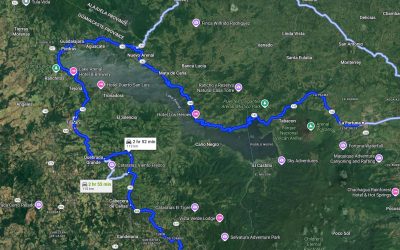Since 1975, I have been fascinated by the idea that humans possibly had aquatic roots. A few decades ago, I wrote an article for Ocean Realm magazine entitled The Aquatic Ape, which invited some fierce criticism from a few anthropologists dismissing it as a silly theory without merit. When I asked them to point out how the evidence that I presented was flawed, they had very little to say other than that it was not a theory given credibility by the established scientific community.
In 1960, British naturalist Alister Hardy presented a theory that he had been working on for three decades. In an address to the British Sub-Aqua Club, he proposed the idea that the major difference in the evolution of human primates that was significantly different from most other primates was that humans had spent some time evolving in a semi-aquatic environment.(1)
When I first heard of Hardy’s theory in the 1970s, my reaction was that it was an idea that answered many questions I had asked myself for many years. I had swum with seals, dolphins, manatees and whales, and always felt a kinship with these marine mammals. I also observed that we had many characteristics in common, much more than we had in common with other primates.
Physical diving mechanism
Like dolphins and whales, humans have minimal body hair, allowing our smoother bodies to move easier through the water. And more significantly, we are the only primate with a physical diving mechanism. This means the ability to hold our breath for minutes at a time, the slowing of the heart rate, the reduction of blood flow to the arms and legs and a gradual rise in the mean arterial blood pressure. No other primate has this ability.
The average person can hold their breath for 60 to 90 seconds. But with training, this can increase up to five minutes, and in exceptional circumstances to between eight and 11 minutes — equal to the average time a dolphin can hold its breath. The Bajau people of Southeast Asia are free diver fishers and routinely dive to 20 meters for up to five minutes. The Ama of Japan are female pearl divers who have been diving for nearly a thousand years. They routinely stay submerged for up to seven minutes.
Let’s take a look at human physical aquatic features and behavior.
- Humans have subcutaneous fatty tissue that conserves heat and assists in buoyancy. All other primates are lacking in subcutaneous fatty tissue, but this physical characteristic is found in dolphins, seals and penguins.(2)
- The dive response restricts blood flow to the limbs and allows the lungs to deflate.
- A relatively streamlined body allows for easy movement through water. If water is poured on the head of a chimpanzee, the hair on the back will resist the flow of water. With humans the hair flows with the water.
- Humans have smooth skin with minimal hair, except for the head where long growing hair serves the function of protection from the sun.
- Long growing head hair also allows for human babies, including newborns, to hold on to the mother or the father. This function tends to be utilized more by females, and men utilizing it less than females has evolved a tendency towards baldness.
- Eyes can see underwater — not perfectly but adequate for movement. The plica semilunaris, a fold of conjunctiva, may be a vestige of a membrane that would have shielded the eye underwater, and allows for clearer focusing.
- The ability to equalize pressure in the ears is possible by pinching the nose and opening the eustachian tube. The human nose shape is ideal for this purpose.
- The human nose allows for the head to be submerged without causing water to enter the sinus cavity.
- Our teeth are ideal for eating raw food from the sea, from seaweed to fish. They can be used to eat almost anything raw from the sea, with the ability to crush crustacean shells and some seashells.
- Squared hands and feet, with slight webbing between the fingers and toes, allow the hands to be used as paddles through the water.
- All primates mate from the rear except humans and bonobos, and bonobos also spend a great deal of time in the water. Humans can mate from the rear, but like all marine mammals the usual mating behavior of humans is belly to belly.
- The palmar grasp reflex in newborn babies allows them to instinctively grasp long hair floating in the water.
- Newborn babies have the ability to swim immediately after birth, and to instinctively hold their breath to rise to the surface immediately after being born.
Larger brains
Intelligence also rose from the sea. Marine mammals are among the most intelligent animals on the planet. Aquatic humans, like marine mammals, had a diet rich in omega 3, an essential fatty acid. Marine mammals have relatively larger brain sizes than terrestrial animals.
The split from chimpanzees to hominids took place some five to six million years ago, and it was only after this split that hominids developed subcutaneous fatty tissue. The questions are, why and when?
In my opinion, one of the reasons that there is so little archaeological or anthropological evidence for the aquatic phase that humanity experienced is that sea levels are much higher today than at the time when proto-humans lived closer to the sea. There most likely is a fossil record buried in the benthic mud.
Australopithecus afarensis lived between 3 million and 3.7 million years ago. The genus Homo originated between 2.5 and 3 million years ago and Homo erectus emerged about two million years ago.
Because Homo erectus was the first Homo species to walk upright, it may have been Homo erectus that experienced the aquatic phase, or an earlier undiscovered connection during a period that could have lasted many hundreds of thousands of years.
Forced to stand upright
It would have been this aquatic phase that contributed to the species standing upright, as spending time in the water would force the body to stand upright.
Many of these aquatic traits could have been passed down to where Homo sapiens evolved some 250,000 years ago.
Life on land was fraught with dangers during the time of the emergence of Homo species. The predators were numerous and efficient. One possible refuge could have been the shallows between the shore and deeper water, where plenty of food could be found and where terrestrial predators were not likely to venture. There were, of course, aquatic predators, but aside from a few exceptions like bull sharks and salt-water crocodiles, most aquatic predators are found in deeper waters.
There has been much speculation about the fact that Homo erectus had a prominent bony brow ridge. One possible reason for this is that the brow ridge would have been helpful for deflecting water around the eyes when the head emerges from the sea. In many ways our eyebrows also deflect water around the eyes, a trait that would be useful for allowing a clearer immediate focus above water as a defense against possible predators.
The fossil evidence is very incomplete, with huge gaps in the records. It was only recently, in 2013, that an entirely new species was discovered in South Africa named Homo naledi. And despite the fact that numerous intact skeletons were discovered, the anthropology community was quick to dismiss the discovery. It was only when Richard Leakey acknowledged the discovery was it given credibility.(3)
The aquatic ape theory has been given credibility by anthropologist and biologist Lyall Watson, writer Eline Morgan, paleoanthropologist Phillip Tobias and biologist and natural historian Sir David Attenborough.
Common characteristics
I think it is quite evident that modern humans share many characteristics with marine mammals. The only theory that has been advanced to explain these similarities is the aquatic ape theory.
What is indisputable is that humans have had an affinity for the ocean. Explorers have ventured forth onto the sea for thousands of years. The Polynesians originated in Taiwan and ventured forth to discover and occupy half the globe, long before the Vikings found Greenland and North America.
Our history is a story of embracing the sea, not fearing it, and I believe that our attraction and passion for the ocean has its roots in prehistoric times, when the sea provided protection and substance and shaped our physiology and developed our brains.
For many years I have advocated that our planet should be called Ocean and not Earth. It is a far more appropriate name. The seas make up the greater part of the surface of the planet, and it is the sea that gives us life. It is also the sea that can extinguish life as we know it.
Since 1950 there has been a 40% diminishment in phytoplankton populations in the sea. Phytoplankton produces up to 70% of the oxygen in the air and sequesters enormous amounts of carbon.(4)
That is why I have been pushing the simple statement that “If the ocean dies, we all die!”
This is the water planet. Water is the essence of life in constant circulation — sometimes in the sea, sometimes in the atmosphere, sometimes under the ground, sometimes locked in ice, and sometimes in the cells of every living plant and animal.
The water in our bodies was once in the clouds, once in the glaciers, once in the sea and once underground. It was once in the bodies of elephants and whales, worms and bees, flowing in the trunks of trees or in the cells of every blade of grass.
In this respect, we, like all living things on the planet, are the ocean — this massive flowing, complex, diverse flow of life that makes all life connected and interdependent.
(17 March 1960, p. 642)
- New Scientist. 17 March 1960. P 642. “Was man more aquatic in the past?” By Sir Alister Hardy
- Wood-Jones F., 1929 Man’s place among the mammals Edward Arnold, London, p. 309.
- Discovery of Homo Naledi by Steven Tucker, Rick Hunter and Lee Berger. National Geographic October 2015. Mystery Man.
- Scientific American. July 29, 2010. Phytoplankton Population Drops 40 Percent Since 1950. Article by Lauren Morello.






